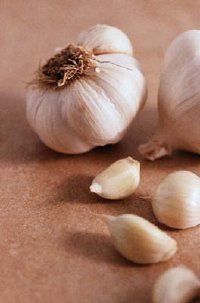How To Grow Garlic
It's easy to grow your own garlic. It's hardy, tolerates cold weather well, and does not need pampering. Whether in a garden or a patio pot, garlic grows well under most conditions and requires little maintenance.
Many gardeners, especially those in northern climates, plant their garlic in October. Others prefer to do it on the shortest day of the year -- the winter solstice in December. Planting in the fall lengthens the growing time so bulbs get a jump start on spring and can grow larger. Some gardeners in more southern climates prefer to plant garlic four to six weeks before the date of the last frost.
Advertisement
Garlic is robust enough to survive the frigid months, but if the winter seems too cold or the snow doesn't form a thick enough blanket over the plants, you can cover the bulbs and emerging shoots with straw or other mulching material for insulation.
You can try planting the garlic you buy from your local grocery store, but some grocery store garlic is treated with a sprout inhibitor that disrupts the natural growing cycle. If you don't know whether your store-bought garlic is treated this way, visit a plant nursery or garden center to purchase naturally grown garlic that is suitable for gardening. If you prefer to try your hand with specialty garlics, visit a garden center or check a seed catalog.
How to Plant
To plant garlic, gently remove the outer skin from the entire bulb and separate the individual cloves, taking care not to damage them. (Leave in place the thin papery skin that covers each clove.) Choose about eight to ten of the largest cloves from the outside of the bulb for planting.
Place the cloves in the ground, tip up, in a place that gets about six hours of direct sunlight per day. Garlic needs to grow quickly to form large bulbs, and full sun fosters fast growth. You'll also want to be sure the area in which you plant will not become waterlogged in winter.
Work the soil about ten inches deep, adding organic matter and perhaps even sand to improve drainage. Bury the cloves in this loose, fertile soil so the tips are about two inches beneath the surface of the soil and the cloves are four to six inches apart.
Apply a weak organic fertilizer every two weeks or so. Water the plants regularly so the soil is moist but not overly soggy, and pluck out weeds that would otherwise compete for nutrients and possibly overgrow the garlic.
Garlic prefers hotter and drier conditions as it matures. If you water the garlic less frequently near the end of the growing season, it will dry out a bit and its flavor will be better. Of course, the amount of water your garlic needs depends on your area's climate, so keep a close eye on your soil.
Harvesting Garlic
It's time to harvest your garlic when the green tops dry out and turn yellow-brown. This is typically about three to four months into the growing season -- late summer or early fall. Some gardeners prefer to harvest their garlic on the longest day of the year -- the summer solstice in June.
Harvest too early, and you get small bulbs. Harvest too late, and the bulbs may split. This indicates that they have already started their next growing season and diminishes their culinary quality.
Before you harvest all your plants, carefully dig up one bulb and examine it. Check its size, and count the layers of papery skin. If the bulb seems well formed, the cloves are plump, and there are about three layers of papery covering, harvest your crop.
If there are four or more layers, let the plants grow a bit longer. When you're ready to harvest, use a small garden trowel to loosen the soil around each bulb. Then dig up the entire plant and shake off loose soil.
Some gardeners save part of their crop for planting again. Others believe that doing so heightens the risk of disease and results in smaller bulbs the next year. Because you can easily buy garlic to plant at a garden center, there may not be a need to save any cloves, unless you cultivate unusual varieties.
After the harvest, your garlic can last for months -- just don't pack it in plastic. Get more tips on the next page.
For more information about the subjects covered on this page, try the links below:
- To learn about how to use garlic medicinally, read the article The Health Benefits of Garlic.
- For more information about how to plant herbs, try How to Grow an Herb Garden.
- If you wanted to know how to cook with garlic, our How to Cook Italian Food article has some great advice.
